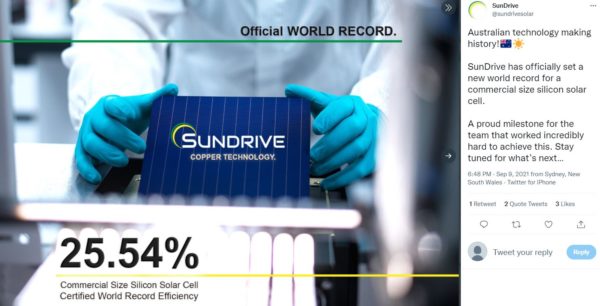Solar cells are older than we perhaps knew, and their efficiency was low in their early development. They were also remarkably expensive. Today, though, materials like perovskite are making new, less-expensive and reasonably efficient cells possible. Swapping copper for the more expensive silver conductors may help make these cells even more rewarding. In a further development, a simple plastic film wrap may make perovskite cells safer. A Long History of Low Efficiency Two dates stand out in Wikipedia’s recounting of solar cell development: 1839 –Edmond Becquerel observes the photovoltaic effect via an electrode in a conductive solution exposed to light. 1883 – Charles Fritts develops a solar cell using selenium on a thin layer of gold to form a device giving less than 1-percent efficiency. Only one Watt would be generated for every kilowatt falling on a one-meter square solar panel. Notice the use of gold helping keep the price of these early cells high. Considering that modern solar cells …
Speedy – and No Range Anxiety
Breaking a record that stood for 26 years, a team of University of New South Wales engineering students have gained FIA recognition for their 500 kilometer (310 mile) drive at an average speed of 106.966 kilometers per hour (66.32 mph) in their solar-powered Sunswift automobile. The Fédération Internationale de l’Automobile (FIA), world motorsport’s governing body, ratified the record for the run set by the team in July. The old record was 73 km/hr. (45.26 mph), making the new record a decisive advancement in electric vehicle technology. The new record is particularly impressive because it’s set by students, more than 100 of whom contributed to the project over the last two years. Students are now working on their fifth car, eVe, to be built and raced since the team was founded in 1996. The University’s press release noted, “’It’s not often you can confidently say you made history before you even graduated,’ Sunswift’s project director and third-year engineering student Hayden Smith …
Nudging the Speed Limit on Solar Power
Imagine driving through the desert with sundown approaching and the gas gauge teetering on empty. Wherever you are when the car runs out of gas or the clock reads 5:00 pm, you spend the night. Competitors in the Challenger Class of this year’s Bridgestone World Solar Challenge had to face this challenge to their comfort and peace of mind every evening for five days. Organizers of this international competition note, “It’s all about energy management! Based on the original notion that a 1000 Watt car would complete the journey in 50 hours, solar cars are allowed a nominal 5 kilowatt hours of stored energy, which is 10% of that theoretical figure. All other energy must come from the sun or be recovered from the kinetic energy of the vehicle. “The elite Challenger class is conducted in a single stage from Darwin to Adelaide. Once the teams have left Darwin they must travel as far as they can until 5 pm …
Batteries Not Included
The University of New South Wales has a long-term solar development program that produces some of the most competitive solar racers in the world – evidenced by their taking a world speed record for solar-only vehicles on January 7 at Nowra, Australia. Their record run was witnessed and awarded on the spot by Guinness World Record officials. “Designed and built by UNSW students, Sunswift IVy is a three-wheeled vehicle with a monocoque carbon fiber body, brushless CSIRO 3 phase DC 1800 W motor, solar array producing about 1200 W (the same it takes to run a toaster) and, usually, a 24.75 kg (55.56 lb) lithium ion polymer battery pack. However, as the milestone is for cars powered exclusively by silicon solar cells, the battery was removed for the record attempt.” Normally driven by engineering students, the car was handled this day by two professional race drivers. Despite partially-clouded skies which ended in rain, the team managed a speed of 88.8 …

